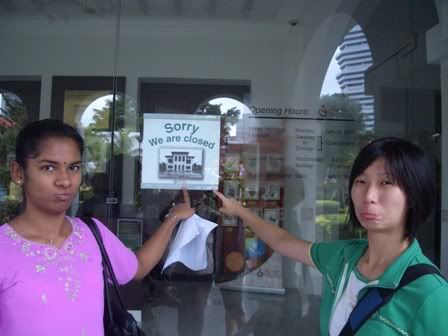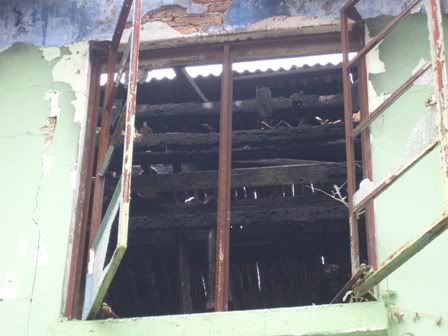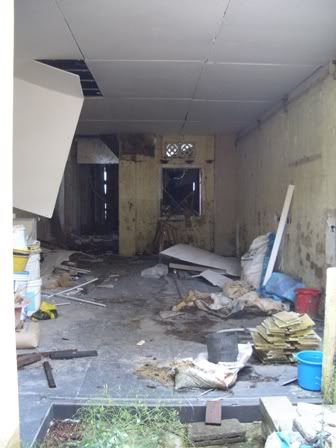I felt a wave of nostalgia hit me when we arrived at the Malay Heritage Centre. In my mind, I saw myself as a 10 year old girl with my friends under a yellow tentage, trying to peep into the Istana in order to have a glimpse at the descendants of Sultan Hussein Shah. We had just heard from our teachers that princes and princesses lived in that big palace. We were all excited to see the royal descendants as we had never seen princes and princesses before, save for the fairytale royalty in the books and cartoons. We did manage to see a few children, who were probably in pre-school and primary school, playing together.
10 years later, I was standing on that exact site but now the whole place was beautifully upgraded. The palace had previously looked very run down and quite boring, to be honest, but now that very palace still stood there, decorated in new coats of rich paint and pretty lights everywhere. Apparently, the Istana has been faithfully restored according to Coleman's design with special emphasis on its setting, retaining the compound, its wall enclosure and the road leading to the building. Timber and cement were used to replicate the interior flooring of the former building. The palace was surrounded by many historic objects like the Bugis Prahu and of course, Gelam trees. There was also a ricksham-like mode of transport that was probably used by the royal family in the past. There was even a garden called the "Scented Garden" that contained plant species like lemon grass and turmeric plant. The reason why the garden is called so is because each of the species there gives off a distinct pleasant smell. I was familiar with the turmeric plant as it is very common in south Indian dishes, i.e the food that I eat almost every living day. I wondered about the significance of having the "Scented Garden" in the Malay Heritage Centre and suspect that the royal family might have used these plants in their daily life acitivities. For instance, lemon grass is largely used in Malay food for fragrance. And I suspect the female royal members may have used the turmeric to remove their superflous hair. ;)
Unfortunately, we were unable to enter the gallery as it was closed.

So we continued the trail.
I was quite taken aback when I saw street signs like Baghdad Street. I realised that I would never have thought it significant if not for the Iraq War.
We coveniently assumed that streets like Kandahar Street were probably named after the place that the immigrants living there came from. Further research proved us wrong. This particular street was named by the British after their possessions and frontiers in the 20th century.
The next site that attracted me was the Lee Loy Hin blacksmith shop. It is believed to be the oldest blacksmith shop in Singapore. Until it burnt down, of course. Before we even identified it as the blacksmith shop that we were supposed to be looking for, Erjin and I were commenting on how the building looked so run down and how weird it was that nobody had done anything about it. I personally found it fishy for the Singapore Tourism Board (STB) to leave it untouched as Kampong Glam, is after all, a tourist destination and the blacksmith shop is located somewhere in the middle of the map of the place. So, when we were looking for the blacksmith shop, we put 2 and 2 together and realised that the rundown building that was still coated with soot and decorated with a half-destroyed rooftop was our destination. Furthermore, it really did help that See Ming had heard about the shop closing down a few years back because it had caught fire. Apparently, some burglars tried to steal the tools that were left unfortched by the fire.






We also found some leftover food products that was already there prior to the fire and has been there ever since the fire destroyed the place. If you look closely at the 2nd picture, you will notice a bottle with something that looks like orange powder.
I also managed to identify a mistake that my primary school teachers made in the past while they guided us around Kampong Glam. They told us that the royal cemetery was where Sultan Hussein Shah had been buried. However, I learnt during our trail that he had been buried in a small private royal grave on the Sultan Mosque grounds, along with his relatives. The royal cemetery that we stopped by at Jalan Kubor was where the Sultan's descendants, for instance Tengku Aysha, who was the great-great granddaughter of the Sultan was buried there along with many others.
One other thing that striked me was how segregated Muslims of various races were. For instance, I noticed that the Muslims that frequented the Malabar Muslim Jama-ath Mosque were largely Indians. This can be attributed to the fact that it is the only mosque in Singapore that is fully managed by the Malabar community in Singapore.
The Malabar community originates from Kerala, South India, particularly from the Malabar region that lies along the southwest coast of the Indian peninsula and forms the northern part of present-day Kerala state. This region was once colonised by the British in the 18th century. Also, because of their orientation to the sea and to maritime commerce, they hosted some of the first groups of Christians, Jews and Muslims in India. Perhaps, the fact that they were under the British just like Singapore and the fact that they lived so near the sea could have highly enabled them to migrate to Singapore.
So, coming back to the topic on segregation, I noticed that not many non-Indian Muslims were present in the mosque. Similarly, I noticed that not many Indian-Muslims were present in the Sultan Mosque. Interestingly enough, when I asked an Indian-Muslim friend of mine, he claimed that the different races that practise Islam feel "more at home" with their own race.
I personally feel that it might be because of the language barrier as well. I noticed that the Malabar mosque had signs in English as well as Malayaalam, which is the native language of the Malabar community. However, the Sultan mosque contained signs in only English and Malay. To be fair, the Fatimah mosque perhaps is the most "multiracial" place of worship for the Muslims as it contains signs in English, Malay and Tamil. There were even brochures in these three languages plus Malayaalam and I also managed to talk to an Indian Muslim man in the mosque.
Did I mention the FOOD?
Shazleen and Shereen brought us to this restoran (Malay for restaurant. DUH.) for Nasi Padang!

Honestly speaking, the food looked REALLY simple but it tasted AWESOME!!!! Just the thought of it makes me want to go back there for more! We didn't order much spicy food as our dear See Ming cannot take spicy food. Personally, I am a sucker for spicy food. The spicier, the better! So you can imagine HOW WONDERFUL the food was, considering the fact that it was not spicy.
And if all this does not seem special to you then how about this. Only the Malay community, not the Chinese, not the Indians, not the Eurasians, not the "others" (I mean no offense by referring to them as others. I'm merely following what the government does :D), holds the pride of having once ruled the land we call Singapore today. And it is the only community that has a royal cemetery in present day Singapore!
And so this is how much I have learnt from the trail and guess what. I am going back there on Saturday, 9th Feb 2008, because I haven't gotten enough of the place and the FOOD! And did I mention that the food there is really good? Haha.
Hema

No comments:
Post a Comment